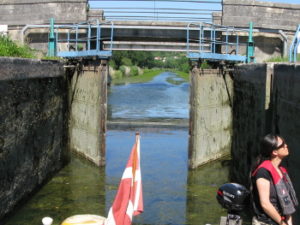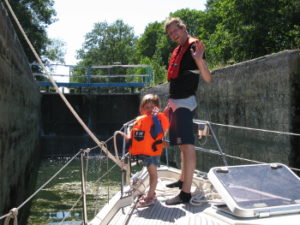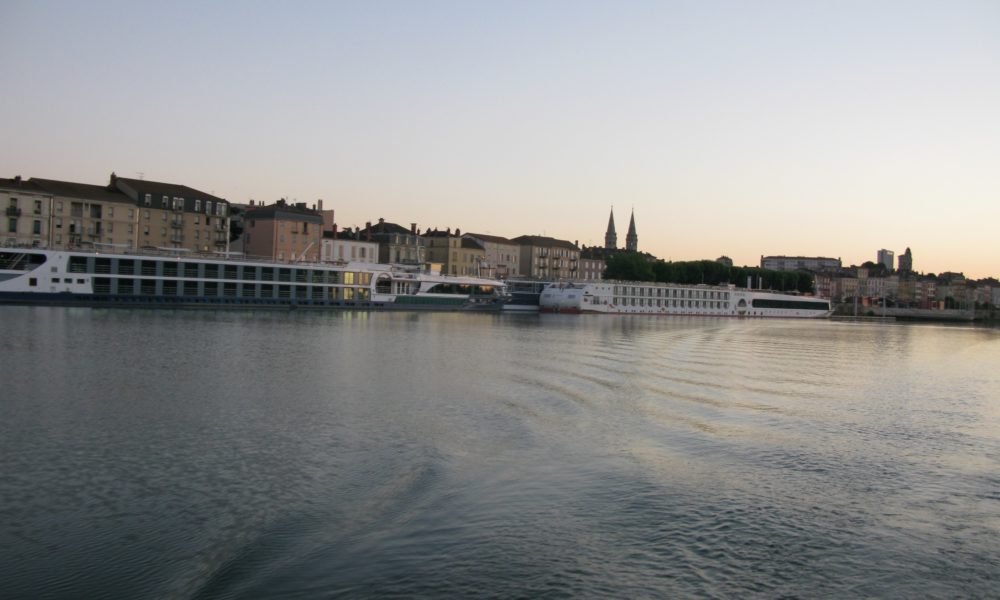
Macon – nice city but do not go there
46° 18′ 24.782” N 4° 49′ 43.431” E
July 19, 2015
Our next goal is Macon – a city of 37,000 people – who were once a major exporter of wine to the Danes. But greed took over, the quality fell, and today it’s almost hard to find a Macon wine on Danish shelves.
It is a charming city. We arrived during Sunday’s relative obscurity but still got a good idea of the beautiful city with its sense of jazz, art and wines. We got to the tourist office and directed to a wine shop and a half kilometre out along the beach road, and there we tried several of the local wines, and we tested some really good Burgundy wines. When you are walking, and one of your feet is still struggling with an injury, you are unsure whether your energy will get you back to the ship. However, close as it was.
We had moored Ronja by a pontoon bridge in the river just outside the city centre. We should never have done that.
We had seen in the chart, that there could be some turbulence in the water at night in this place. We had also read a cryptic expression that the pontoon bridge was home to “.. rather unusual animation”. We had discussed, what this message could mean. Mice, rats, insects … special? It turned out that the bridge was used by several young couples dating in the dark at evening. The first came at 10 o’clock p.m. The last past midnight. On top of this a general noise from the city, some annoying speedboats that showed their strength back and forth with huge motors-swells to follow, and then a few large hotel boats docked behind us in the middle of the night with giant spotlights, that illuminated our entire bed.
Next time here, we will certainly skip Macon. The city do not master the mix of different types of boats. Speedboats and personal watercraft roars through the water far beyond the limits specified in the chart. The commercial river-crossing operating at the time, where the rest of us are trying to sleep. Poor cocktail. Stay away from Macon.
Log book: Today’s distance: 62 km. Sailed time 7:00 to 13:00 = 6 hours. Locks: 1. Weather: Rain last night and a proper lightning storm in the night broke the heat wave. We get a gorgeous morning with a bit of rain and clouds. And when the sun comes through at noon the temperature never got higher than 29.
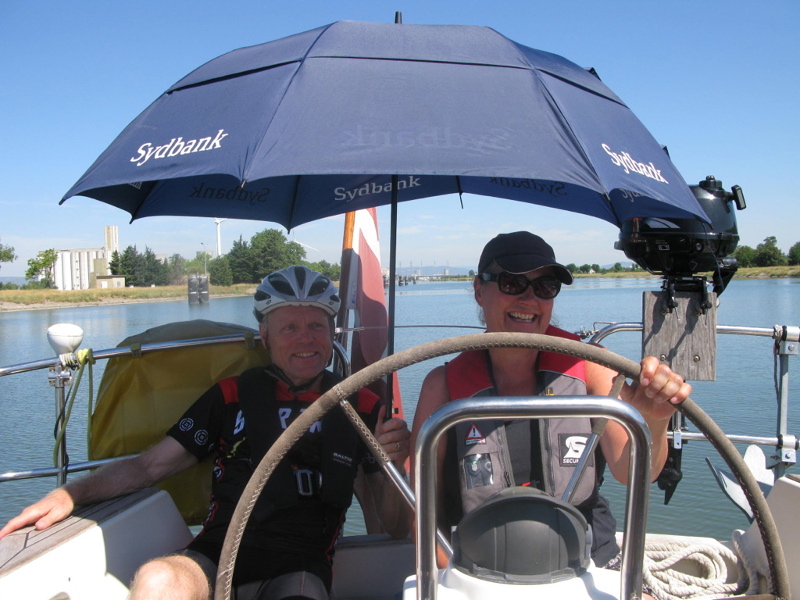

Chalon-sur-Saone – young and lively city
46° 46′ 37.794” N 4° 51′ 37.0872” E
July 18, 2015
Rain? Yes, it’s raining! Not much. But still. Per goes to the bakery, sliding on the unfamiliar rain-soaked rocks and after having brought home a baguette and two croissants he i repaired on his knee and hand chlorhexidine and patch. Later it turns out that the worst injury is a sprained foot.
Despite the obstacles we start early from St. Jean de Losne, get a terrific morning on the river with lots of anglers along the banks and in small boats. Several people catch fish, just as we sail past. Some anglers are very friendly, they wave and yell bonjour, but the other lets us with their body language understand, that we should not even sail in their fish river.
It goes fast now. 70 km in around six hours. Just over lunch we arrive at Chalon-sur-Saone, a relatively large, young and lively city, that we have heard many good things about. Kirsten confirms after a tour of the city that it is just the city, we have been longing for. Beautiful buildings and squares. Charming neighbourhoods with restaurants. Here is life. Here is beauty.
Per was sitting at home in the cabin, groaning under the now 35 degrees and foot wrapped with an ice pack to soothe pain in the sprained foot. Kirsten has taken pictures in the town to document the beautiful city, he will not discover himself.
Log book: Today’s distance: 70 km. Sailed time 7:30 to 14:00 = 6 1/2 hours. Locks: 2. Weather: Magnificent morning. Overcast. But later the sun breaks out, and we are quickly back to 35 degrees.
In the stronghold of inland waterway sailors
47° 6′ 3.1968” N 5° 15′ 52.2792” E
July 17, 2016
We shop and break up. The air is sultry. The weather forecast promises 38 degrees, perhaps with thunder. It turns out to be a fine decision to drop the extra day in Auxonne, for out on the river there is wind and relative coolness. We sail to St-Jean-de-Losne – inland waterway sailors stronghold. Here, the multiple channels run together. Here, most sailors pass, whether south or northbound.
In a large inner harbour are 250 large riverboats. At the start of the Canal de Bourgogne is a further hundred, and out on the Saone River is the major, rebuilt boats and people like us, who with a draft of 1.75 cannot enter the inner harbour without going aground. The official Fluvia chart says otherwise, that there is room for a draft of 1.80, but several have warned us, that it has no basis in reality. There is a maximum of 1.40 meters.
After getting diesel from something as rare as a river located diesel station, we place ourselves beside a warm Dutch couple, who have moored in the river and signal us, that we are welcome outside their boat. Shortly after we get an extra bout at our side – our friends, the Swedish boat Sofia, who like us are heading towards the Mediterranean in a maxi-yacht. The boat is sailed by a couple, who are on leave until the end of October and wants to sail around Greece, where the man originally come from. He moved to Sweden in 1987.
We have been sailing with them – more or less – since Chalon-sur-Champagne, where they witnessed our fatal motor collapse on the day, that we since have tried to forget.
We explore the city. It is more charming than Auxonne, less poor, less worn, and a little more accommodating. At the same time, however it is a tiny town with its main profile from the riverboats lying all year round for the repair, winter storage, conversion. We move around in slow motion from shadow to shadow to not be affected by the heatwave, which, , according to the Norwegian weather service YR thankfully is over tomorrow, then instead we get rain showers and only 27 degrees. Hallelujah! It will be a celebration.
We are happy with YR, probably because they often promise better weather than other weather services. But let’s see.
The worst thing about heat waves are the nights. The many hours where you are bathed in sweat trying to rest. We remind ourselves, that if you want to explore the hot countries, you have to accept the heat, that comes with them. But we actually discuss these days, that conclusion on our “Ronja Around the World trip” may be, that the very best sailing ground in the world is Denmark. Well, right now we cross our fingers, that YR gets the weather right.
Log book: Today’s distance: 18 km. Sailed time from 10.00 to 12.00 = 2 hours. Locks: 1. Weather: Unbearable in port. The sun beats all day long.
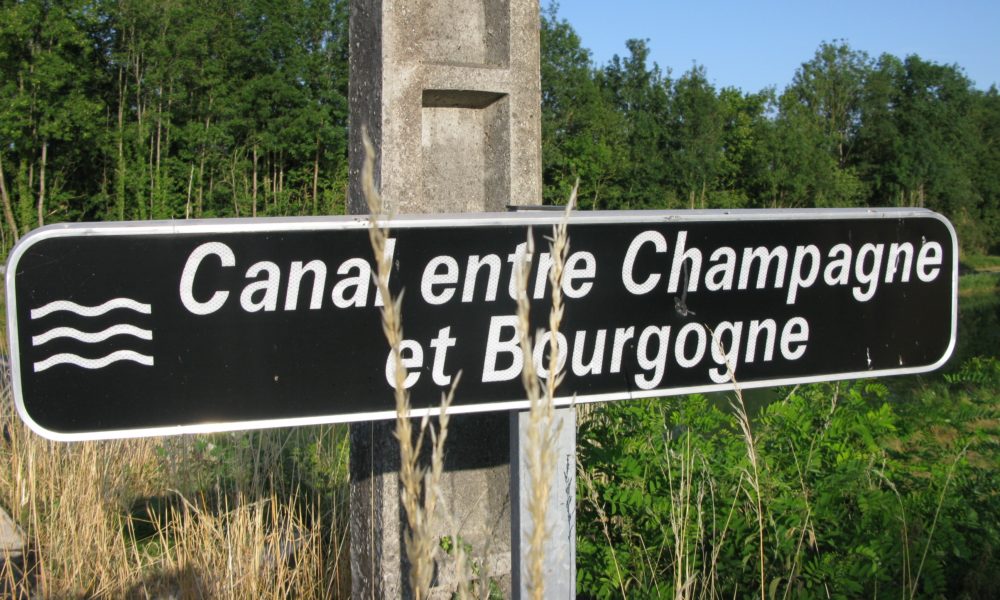
Let us get away from these small locks
47° 11′ 52.854” N 5° 23′ 13.7112” E
July 16, 2015
We want to get out of locks. Now. Basta. Therefore: Up early. In good time for the first lock to open.
Sigh. It does not respond. The light is not green, when we beam the remote at it, and it does not give us a red light even as a starting point. It is completely dead. Straight on the phone. “Parlez vous anglais?”. “No“. Just listen to this: “Ecluse numero 36, avalant, ne functionne pas …”. They will send a man. He asks why on earth we will further south, when it is already so hot here in the north. Well. Good question.
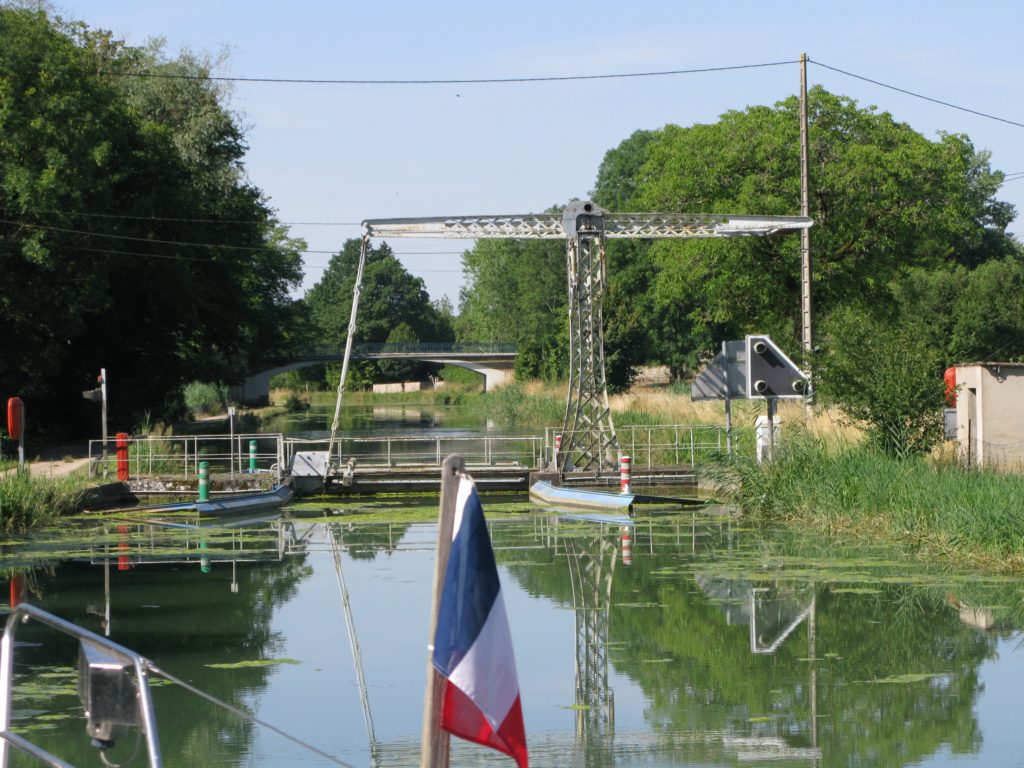
Shortly after it is a small bridge, that will not rise. We grab the phone: “Parlez vous anglais?”
After the very last locks of the Canal entre Champagne et Bourgogne we sail into the Saone river and we observe an instant switch from the narrow channels. Here is traffic. Here is life. Other boats. Many rental boats with children. Extra water under the keel, longer between banks, more anglers along the coast.
Great! We are sailing faster and calling Auxonne, which to our surprise turns out to have a marina with 150 berths. So great a port, we have not seen for years. Strangely, to see a full port without a single mast. But thats the way it is in these parts of Europe.
We need to get ashore and move. We walk around in the city. It is characterized by a large military barracks, a huge church and some really old houses. The barracks are for infantry and artillerymen. Napoleon served here in a period of his career.
We are looking for cafe with Wi-fi – several café owners tell us, that they would never dream of having a thing like Wi-fi – and when we finally find one, we celebrate the change between channels and river with a glass of champagne. We eat at the best restaurant in town, Hotel Corbeau, which stands out clearly – the other consists mostly of kebab and pizza places. Corbeau’s food is excellent. The best so far on the trip.
We are talking with several Danes, who have rented boats on the Saone. We also meet Moodi and Carsten in their sailboat, Nicoya, from Rødbyhavn. They are on their way home over after three years in the Mediterranean, and are chock full of good advice on long-distance cruising. We invite them aboard, and while we contribute a few observations about where they should beware of low tide and extra seagrass in Canal entre Champagne et Bourgogne, they are giving their experience of good harbours in the Saone and Rhone, interesting ports in southern France and the best places in Greece, where they stayed for a few years.
We hear about cockroaches, cockroach traps, about the importance of washing fruit and vegetables piece by piece, before we take them on board, the professionalism of Navy Services in Port St. Louis (that’s where we hope they continue to keep our mast and boom). We hear about the terrible port prices all along the coast of Italy, bad everywhere but worst from Rome and northwards, where the price for a night port adds up to 70 euros or even more, without even having special facilities. One of their tips is, that if we want to enter and see Rome, we shall sail up parts of xxx river and moor at one of the shipyards. There we can moor free and take the metro into Rome.
Carsten and Moodi, respectively 61 and 59 years old, have been on long voyages twice. The first time in two years. Later in three years. He has been taking early retirement. She did not yet.
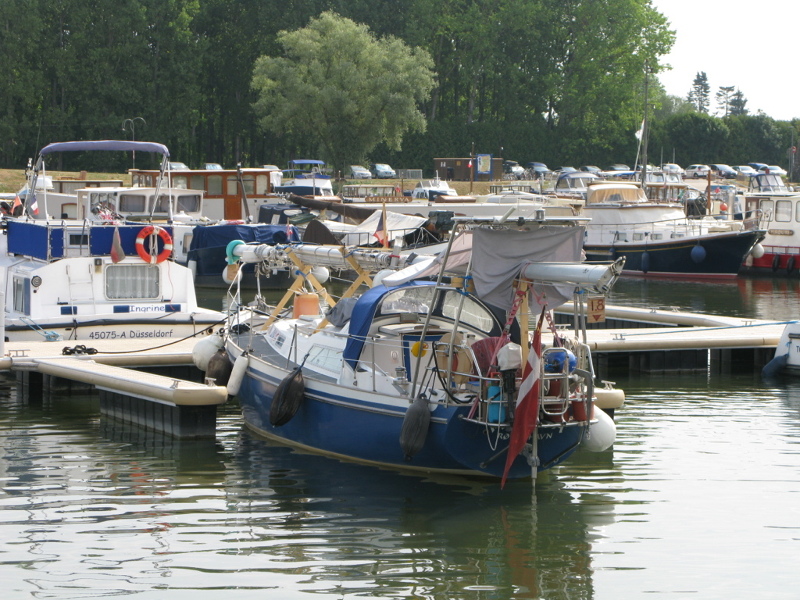
Moodis and Carstens boat
They would have sailed home from Greece to the south of Sicily and via Menorca, Malorca and Corsika, but because of the current refugee situation they did not dare do it. They had experienced episodes of refugees in large rubber boats in Greece, and the thought of having to pass Lampedusa made them choose the Messina Strait instead.
It is no longer just the Somali coast, that sailors should take heed of, but also the Mediterranean where Carsten and Moodi knew of stories of gunfights between police and human traffickers, and where they frankly would not ever know what they should do if a few hundred refugees from Africa would board their small sailboat from Rodby.
Log book: Today’s distance: 39 km. Sailed time 7:00 to 15:00 = 8 hours. Locks: 10. Weather: 38 degrees. The heat wave is back.
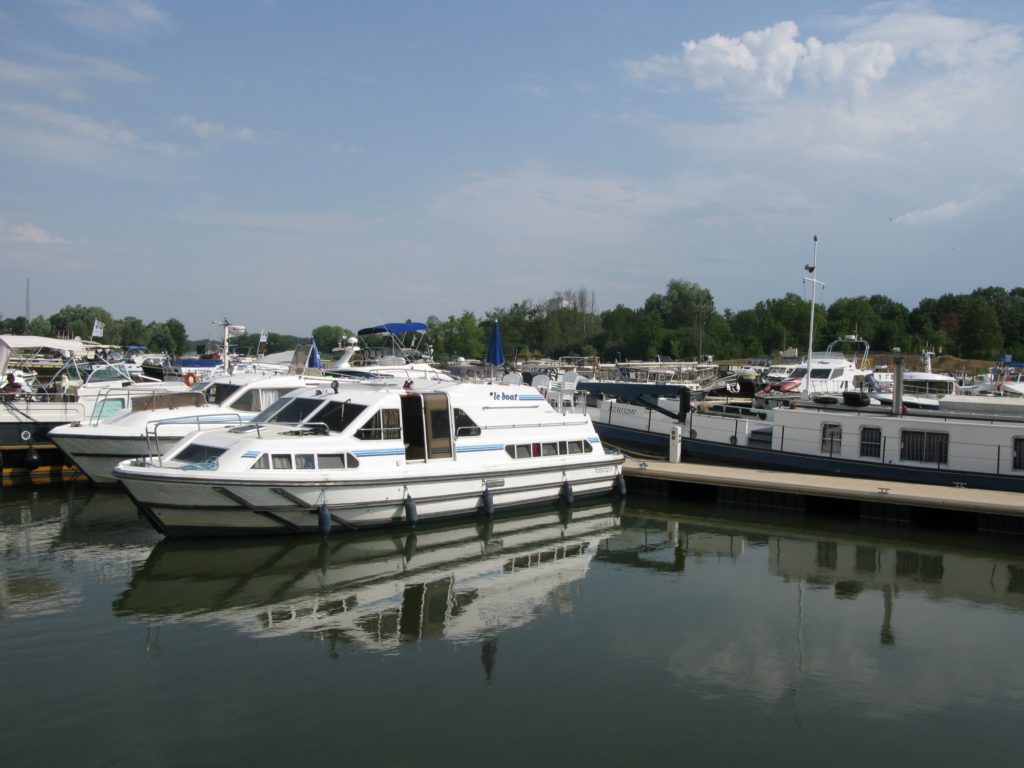
Auxonne in Saone river turns out to have a marina with 150 berths. So great a port, we have not seen for years.
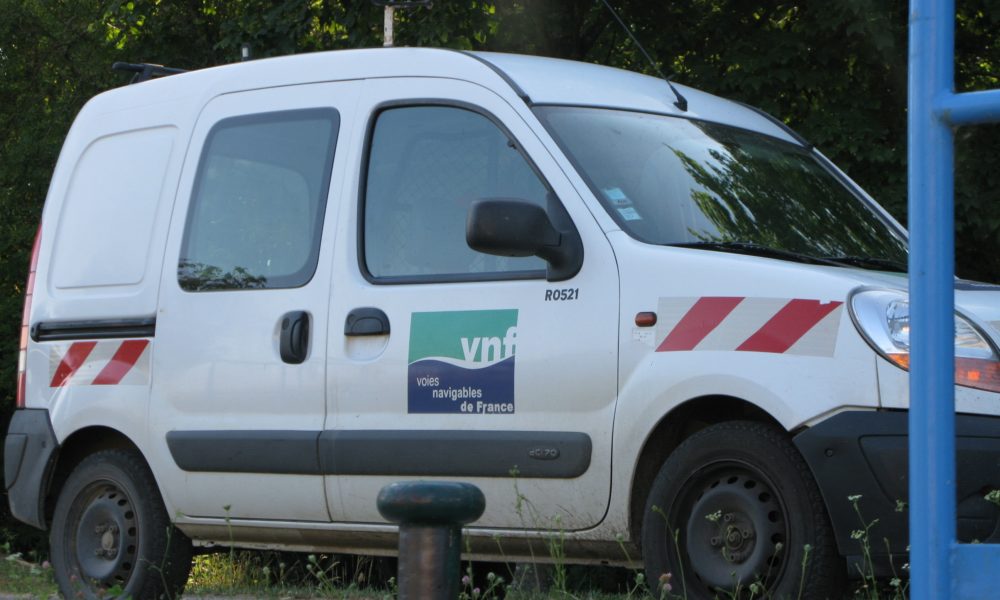
Help us out, we want out of the locks!
47° 27′ 41.8392” N 5° 22′ 19.6932” E
July 15, 2015
We are starting to get tired of the locks. We cannot bear any more of them. We have done more than a hundred locks since we started the holiday one and a half weeks ago. Now enough is enough.
The only sure cure for this is to sail out of the channel, and we still have 28 locks in front of us before we are done with Canal entre Champagne et Bourgogne and can sail into the river Saone. So we carry on with the locks again today.
The locks are close to one another at this side of the mountain. In turn, the weather has been a challenge. More than 30 degree celsius already at the end of the morning, we are confident. We therefor start early. Before eight o’clock. It gives us some cool hours, where everything works. But then we come to sail behind a peniche. And we are in a series of locks under remote control.
We call again and again to VNF. “Parles vour anglais?” We ask hopefully. “Pas du tout” is the response almost every time. And then we have the trouble. Per embarks on his through the winter updated French: “Ici batoux plaisance Ronja. Avalant (declining). Nous sommes a ecluse numero 32. The shit does not work. The lock is red, and not a damn thing is happening, when we use our remote control. ”
Amazing what you learn at evening-classes at FOF in Odense (running french-lessons) even without excessive diligence with homework.
VNF come and fix the error within 20 minutes. Only a very few times we have to make an additional call.
A place to moor for the night we find a kilometre after lock 35, Beaumont. We put Ronja under a grain silo. Only ship at the spot. No other boats have ventured to sail as far forward in the lock system this day.
Let’s get out of the locks. Tomorrow we have nine locks back, then there will be free passage down the Saone River, where we expect the city Auxonne to be the first stop for more than just one night. From there the rest of the tour will be 14 days with only 16 locks between us and the Mediterranean. Great.
Log book: Today’s distance: 33 km. Sailed time 7:45 to 18:00 = 10 ¼ hour. Locks: 20 !!! Weather: Sun all day. Possibly 35 degrees. We have no thermometer. But clearly one of the hottest days at all. We rig a large umbrella to create shade for the helmsman. Comfortable on the straights. A hassle during the lock operations.
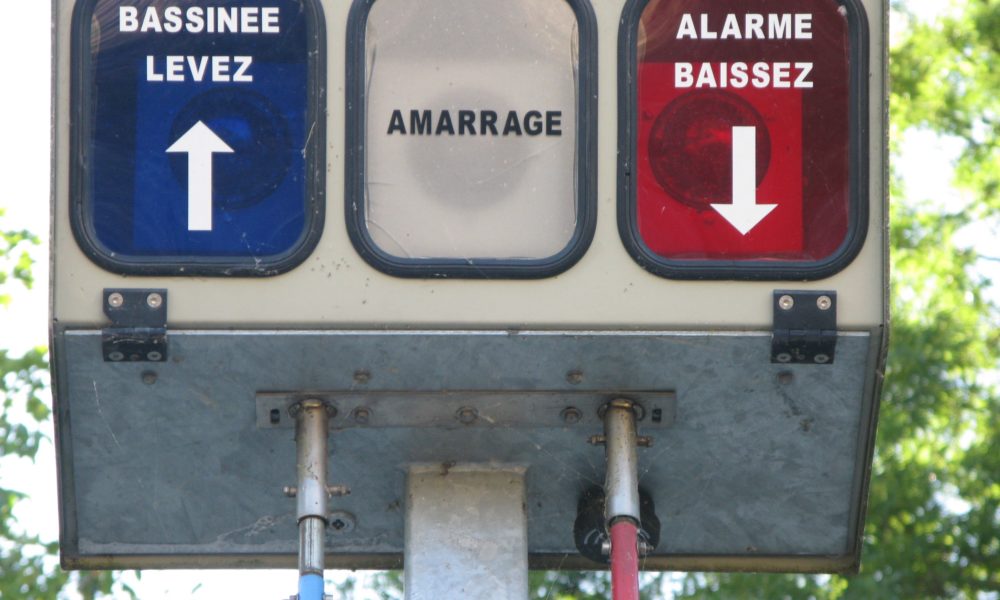
Hey! 24 locks in one day…
47° 41′ 2.2524” N 5° 20′ 41.3196” E
July 14, 2015
Effective day. And pretty exhausting. We have agreed with our neighbours from Bruges in Belgium, that we will break up with them as the first of four boats, and that we follow them through the locks. Their boat, Eva, is a broad-obsessed lady, totally strapped into a corset by huge fenders all around. They offer to go first into the locks. We say yes.
The day is laborious. Lock in and lock out. Some locks on this stretch are operated by young students ,who whiz off on their mopeds to make the locks ready for us. Others – the majority – are automated and controlled with the remote control, we have been given. Today’s highlight – literally – is a voyage through a nearly five-kilometre tunnel drilled through the mountain top. Dark, damp, clammy. Water drips onto our heads. The lighting is low, just enough that we can see to keep us in the channel. We keep a flashlight in reserve.
Our start in this tunnel, Balesmes sur-Marne, was governed in good bureaucratic French manner. A series of red and green lights in the tunnel ceiling are holding us back or invite us forward, depending on whether we are sailing too fast or too slowly. Circumstantially and annoyingly engineer-like. One senses that someone sits in a central office and plays with us.
The lock is a turning point. Since the beginning of Canal entre Champagne et Bourgogne, we have only been sailing upwards. 71 locks in total. 340 meters, we have been lifted since the channel start. From now on it is downhill. Right down to the Mediterranean, we think.
We use the first locks after the tunnel to get used to going down. It is said that this is much easier. More gentle to the ship and crew. For us, it is necessary however to catch the technique. In the first locks, we use the same technique, as when we locks up. Two hawsers. One for each, close to each other. It gives a sense of control when it goes up.
But going down there is not as much pressure from floodwaters in the lock chamber. The water disappears quietly under the boat. It is much calmer, and we become comfortable with simply having a single rope to the land, while we are experimenting with making as few moves as possible and let the boat take care of itself. A single puff with a boat hook or a single jerk in the hawser is enough. Yes, obviously it is easier to lock down than up. If it were not for the sun and heat, it would be pure relaxation.
We say goodbye to the Belgians after having sailed with them through 20 locks. Although we are taking additional four locks to Dommarien, which according to the map is a berth with 1.80 meters depth for two boats. It is not.
We hit the ground long before, we reach the quayside.
Instead we sail to the right side of the canal, where a converted peniche populated with young French people is located at the brink. We ask if we can moor side by side with them. No. They ask us to find another place. Rather unheard of. Sailors always give each other space. But they are probably landlubbers. Not sailors. Kirsten, frustrated, calls all sorts of curses upon the young landlubbers.
We must try again on the berth assigned in the chart. Nope. It is impossible. We cannot reach the shore. There continues to be one to one and a half meters between Ronja and the brink. We choose to make the boat stuck on this distance of the brink with the assistance of a helpful Frenchman. Well, anyway it does not seem temptating at all to go ashore, so we do not.
The helpful Frenchman seems to be new to sailing life. He has a small motorboat, which he has connected to the shore with three ropes and an anchor, which he has fixed on top of a little metal-bridge. We have never seen this before.
We celebrate with champagne today, the impressive distance and the fact that we have passed the peak and that the next few weeks of sailing goes down towards Saone, Rhone and the Mediterranean. A clear turning point.
Log book: Today’s distance: 35 km. Sailed time 8:45 to 19:15 = 10 ½ hour. Locks: 24 !!!! Weather: Sun all day. Light breeze made sure to dampen the unit. In these waters, the wind has only one meaning: To cool. To the navigation it has virtually no impact.
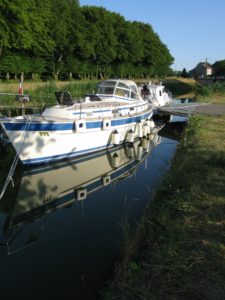
Sometimes you have to improvise finding mooring for Ronja
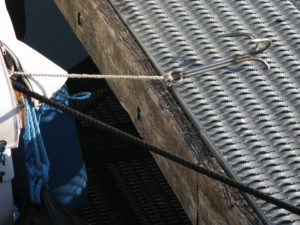
Not alle french sailors are trained in the craft of mooring. Her is a peculiar use of an anchor
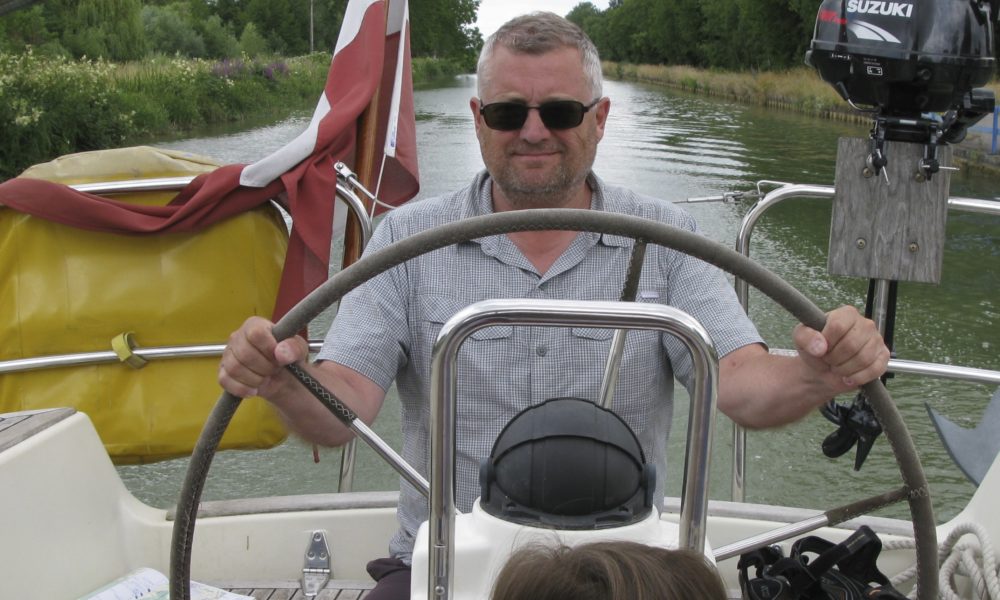
The lock system and almighty VNF sets the speed. Not you…
48° 18′ 1.7748” N 5° 8′ 48.9516” E
July 13, 2015
We say goodbye to Lasse, Tianling and Nellie. They want to go to Alsace, Germany and Denmark to find the wildest playground for Nellie. Instead of making departing into something sad, Lasse told Nellie that they now will start a hunt for a wild playground, and this project she is very pleased about. In today’s first lock they stand and wait and surprise us with an extra goodbye.
It requires patience to sail the French channels. The channel is in control. The lock system and the almighty VNF decide. Not you. Others set the pace.
You may be very much accustomed to the ways things are done back home on the job. You make things happen. Putting things off. Monitor progress. Intervene and speed up if a project loses momentum. On the canal is different.
The locks are based on a centuries-old system, which in recent years has been partially automated, but which are nevertheless based on the same routines and procedures. First notify your lock – via VHF radio, via a mechanical turn on a hanging rod or via a remote control – that you want to get through the gate. Then the lock reports back, that it has received your message, and it will start working on it. After some time – it can feel like a very long time – closes the farthest gate, and the emptying or filling of water begins. It takes time.
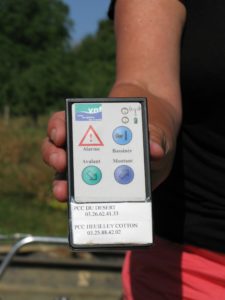
Remote control for operating the modernised locks. All is in french. But anyway the system is simple
From your position you can see the water gushing out, or – if you are on the decline – pouring into the lock chamber. When the water in the lock chamber has reached the same height as your part of the channel, which takes quite a while, a beep will sound and a flashing light shows, that now starts next stage in the process. The lock opens the lock chamber. It goes slowly. Very slowly. With high probability is this slowness carefully thought of some engineering minds, who wanted to avoid accidental rapid movements. Slowly, slowly, the front gate goes up. You can go in and find your place in the chamber.
Here begins the next phase. You give the lock a message via a mechanical lift on a blue rod or with the borrowed remote. You want to have the lock emptied or filled with water. It thinks a little about this. Often you may provide an additional signal. Again, the system is put together, so it makes quiet movements, time for reflection, time to get out of the way, no panic, in french: “lentement, lentement…”
There are those, who will argue, that it is healthy for the average busy person. Well there are even those who would argue, that this enforced tardiness is the very idea of a sailing holiday. Here you will be subjected to nature and other forces greater than yourself. Here you must adapt your thinking and your pace to others. Down to speed. Accept that others set the pace.
We are not angels. But perhaps it is still part of what we call the holiday, to be forced into a very slow pace.
Log book: Today’s distance: 29 km. Sailed time 9:30 to 16:00 = 6 ½ hours. Locks: 15 pcs. Weather: Perhaps the best sailing weather we had. Slightly overcast skies. Warm without being oppressive.
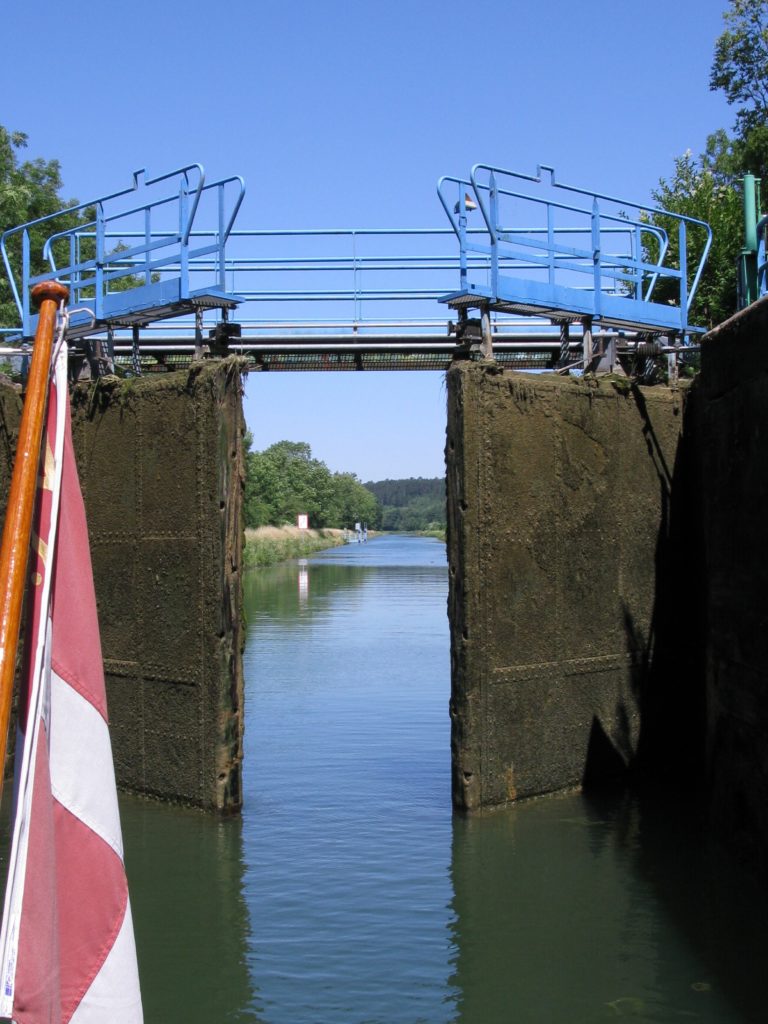
Locks forces you to go down in speed. Everything takes place in slowmotion. Probably good for something. Stress, maybe?
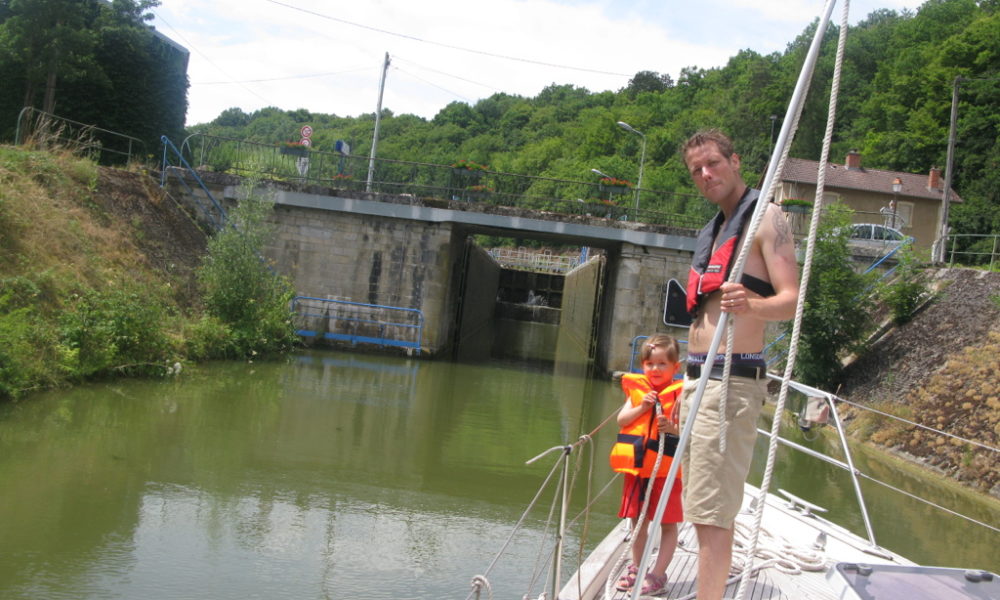
Worst distance till now: Ronja hit concrete-bottom
48° 26′ 36.5136” N 5° 8′ 15.6768” E
July 12, 2015
Today Kirsten is the one, who runs the family car. She takes it to Chaumont and will wait for Ronja to arrive mid-afternoon. It is the last day with a this car, it is returning to Denmark, and Kirsten fills the car with new 48 litres of spring water and a lot of other necessities. Later after bunkering we also go for 40 litres of diesel from a gas station three kilometres away. So nice to have a car.
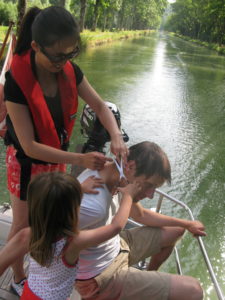
Haircutting at sea
In terms of sailing this is the worst trip so far. The day starts in fine style. Lasse and Tian Ling organize a hair salon on the aft deck. Lasses hair is cut in the breaks between locks, and Nellie tests our camera. We let her do it, although we can see, that she is pressing all the buttons and putting fingerprints on the lens. She experiments. And that makes some funny pictures.
Today’s nightmare starts immediately after lock 26, Condes, which leads us into a 308 metre long tunnel. As we approach the end of the tunnel, we see a group of boys shouting and gesturing to a buddy, who apparently is standing on top of the tunnel, ready to jump into the water. In itself wrong. The bridge over the tunnel is five or six metres above the river, and the river is only 1.80 metres deep. We can see, that the boys have a hard time convincing their buddy, that there is actually a ship coming out of the tunnel, and that he must not jump, and we also begin to roar loudly from the tunnel that here we come. “Get out of our way, please”.
He is not jumping. Obviously it is his first leap, and he is not as brave as his friends.
Then follows the three most terrible of kilometres, we have ever experienced with Ronja. She scrapes along the bottom. On long stretches of three even four hundred metres we hear and feel, how we scratch across the bottom of the canal. Heavy. Speed disparaging and horrifying. Can the boat can stick to this? Sometimes we hit an irregularity in the bottom, which gets Ronja to evert in an eerie bump, while she works over the obstacle.
We keep the engine to 2300 revolutions. We go on. We find it difficult to see an alternative. If we slow down, we will become hopelessly stuck, and then we will certainly not make it through. It will be three long kilometres. Our relief is great, when gate 27 turns up. Here the sea level is not flashy, but deep enough to once again flow with all of Ronjas beautiful body in the water.
Most of this summers stretch the bottom has consisted of mud, and that is not so bad. It takes some speed, when Ronjas keel plods through the mud bottom. On this particular stretch, however, is a rough and uneven concrete bottom. The channel is cast the entire stretch between locks 26 and 27. And the water level is significantly below the promised 1.80 meters. We later find that it is missing 40 centimetres relative to mean sea level, due to lack of rain, and because VNF has not levelled out the differences. VNF has lakes higher up, which they can use to send extra water down the system, when it is missing.
The sailors at the next port are all angry, that this has not happened.
Logbog: Today’s distance: 25 km. Sailed time 9:30 to 15:30 = 6 hours. Locks: 11. Weather: Sun all day. 27-28 degrees
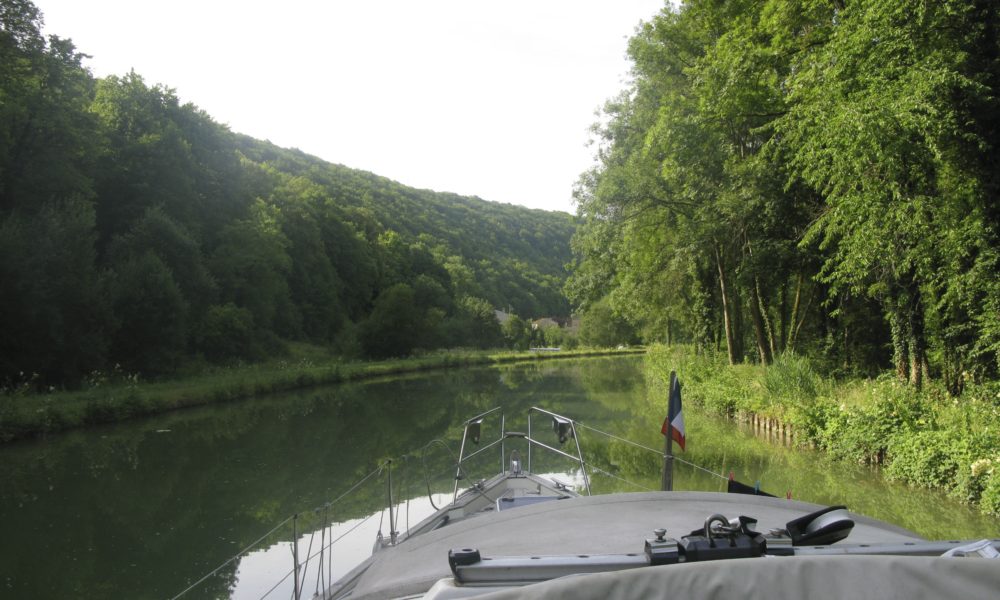
Sailing in the midst of the most beautiful nature
48° 6′ 49.4928” N 5° 8′ 21.3216” E
July 11, 2015
Two pieces of cake wrapped in tin foil is the farewell gift from the nice Brits, who will stay for another 10 days, because they are watching a dog for a friend. “We usually give the cakes to lock keepers,” they say. We ask if they are sailing all year. No, no. “The winter we spend in Spain. Only in the summer we sail in France “.
Today’s retirees have many ways of organizing their lives. Previously, we have spoken a few times with a Dutch couple, who no longer had a permanent in the Netherlands, but in the summer months sailed on the canals of Europe and in the winter lived in their apartment in Cape Town, South Africa.
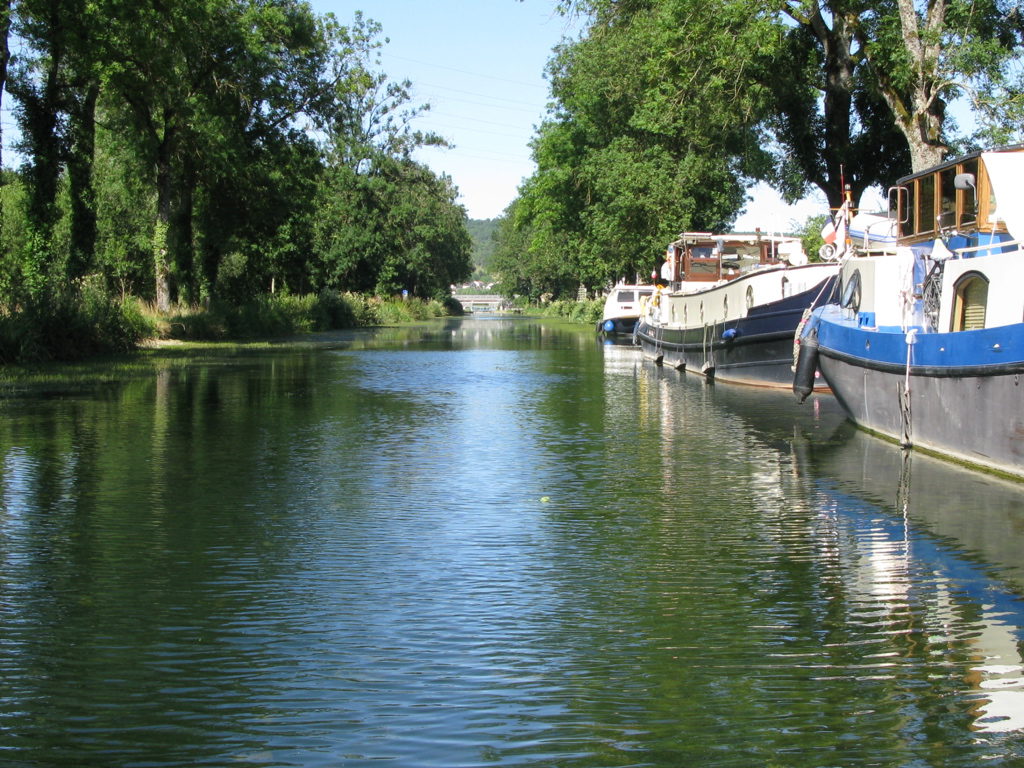
Marvellous mooring side by side with british vessels rebuild from business to leisure, spacey and modern
The ride is beautiful. The canal is curving through the landscape. Completely different from the straight channel-stretch, we have been accustomed to. Beautiful hills, rolling cornfields and lots of flowers close to the canal. The intense nature close to us is the big attraction of sailing on a canal. The banks made up of a tangle of flowers – climbing plants, thistles and many others – with purple, yellow and white as the predominant colours. A paradise for insects and birds. Dragonflies play tag. Venom spider webs are evident in the early morning hours and above us eagles are flying.
The only snake in paradise is the green sea cucumbers, which at long distances reduce our speed to less than two knots, because the keel plods through the wild growing of underwater plants. Periodically we put the engine in reverse to free the propeller of plant residues.
Lasse is driving in advance with the “follow car”, which is parked at a small jetty in Froncles. Five boats and five campers around a small piece of grass with electricity and toilets. It is fairly standard for a port in these parts. After having parked the car, he runs 14 to 15 kilometres back and meets us in a lock. Tianling jumps also gets of the boat on the way to take a walk.
It’s great to have Nellie on board. She is three and a half years old, and she is quickly settled on the boat. The large living cabin in the middle is hers. Here she is playing with clay, Legos and drawing. Here she sleeps at night. Quickly she finds out how to move around in the cockpit. Only once it goes wrong. She fell and hit her head against the rudder stock, but a heron flies over at the same time. “Look, Nellie, your happiness heron. It will see if you are seriously injured, and now flies further. ”
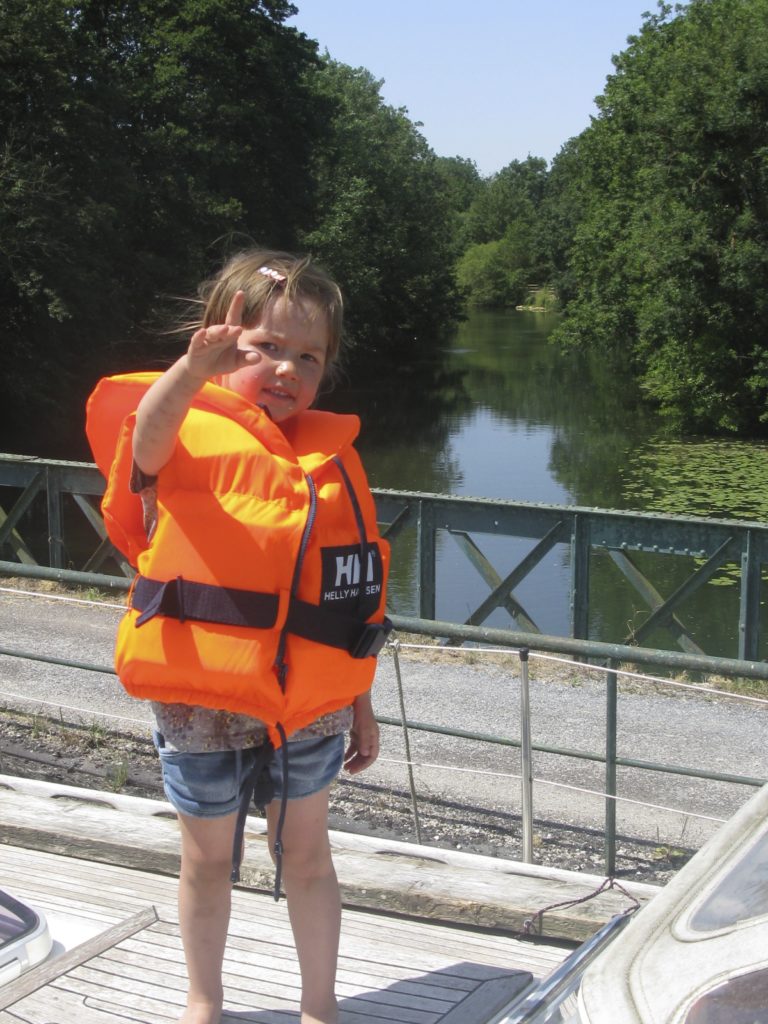
Grandchild Nellie wears lifejacket whenever close to the water
The hardest part for Nellie is the limits that naturally must be on a ship. In the cabin and cockpit, she must be without a lifejacket. But up on the deck and along the quay in the port she must always have a life jacket. After some border dispute on this, it is accepted as one of the terms of sailing life.
Log book: Today’s distance: 24 km. Sailed time 9:30 to 15:30 = 6 hours. Locks: 9 pcs. Weather: Warm, sultry, sun.
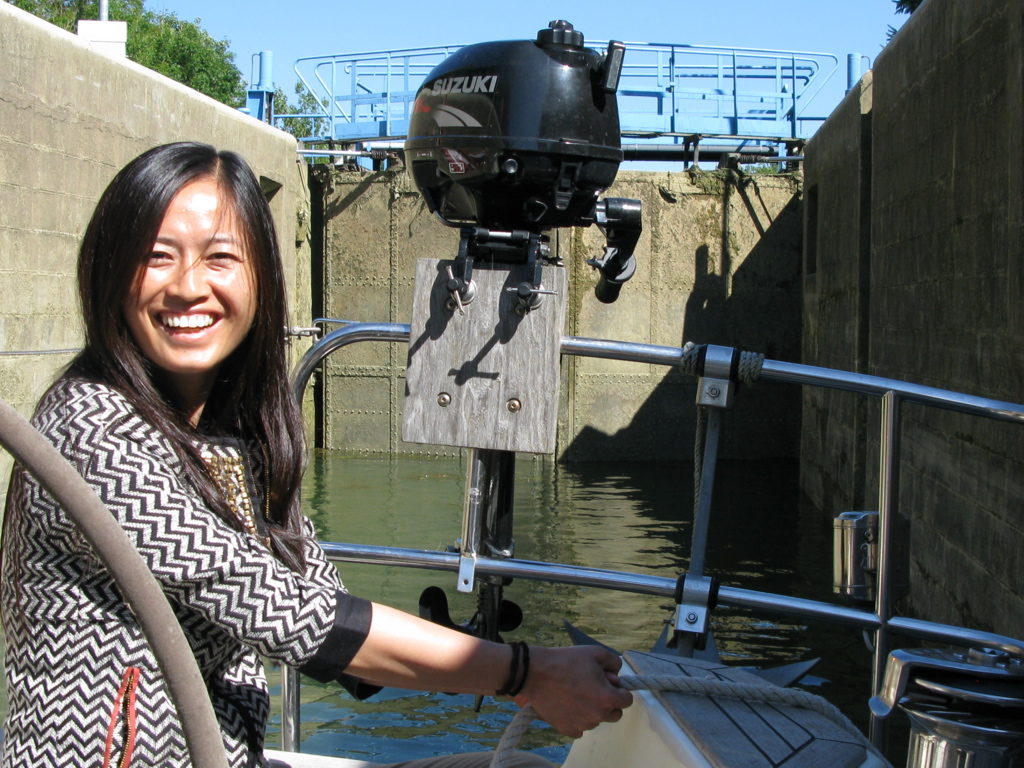
Tianling improves every day in her relatively new role as mate onboard Ronja
Help, we are under attack by green sea-sausages!
48° 37′ 1.4928” N 4° 57′ 1.3216” E
July 10. – 2015
Fresh bread. Fresh water on the tanks. New starting battery for Ronja. We are ready for a new day. Lasse drives the car to Joinville and park it, at what we assume to be our next stop. It is not. More about this later.
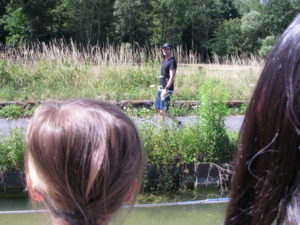
In turns we take a walking- or jogging-tour along the river. The sailing here is a bit boring, so any kind of variation is wellcomed
Lasse will run to meet us from Joinville, 24 kilometres further down the canal. He manages to run 17 kilometres, before we have him on board again.
A full day of sailing. Most locks are ready, when we come to them. Only problem is a wild, green sausage-like plant that causes the sonar to signal constant danger – 0.0 meters below the keel – and which slows us down to something like 50 percent.
We are sailing through an underwater jungle of thick, spruce-like plants that spread out from the shore and appear to be in the process of conquering the entire channel. Only in a small stream in the middle, we can fight our way forward. Regularly we had to put Ronja at full speed astern, then full speed ahead. This will free us from the most aggressive of the green sea sausages. If the French do not find out how to keep these growths down, it may close the channel-tourism in a few years.
All this coming and going. Shortly after Lasse boarded after his run, Kirsten buckles her sandals to go ahead and explore the possibilities for accommodation by walking along the canal. While we struggle our way with only two knots between the aggressive aquatic plants, Kirsten talks to people along the canal and with captains of a few peniches.
Do not stay in Joinville, they say. It’s expensive, and it’s boring. They have found a place one kilometre before Joinville. The site is located “in the middle of nowhere” with a view of fields and forests. The facilities consist of a bench. No electricity. No water. No waste containers. In return frogs croak and the channel beckons with coolness and fish, so many that a three year old can capture them with a fishing-net.
The channel is not deep enough for us to get right to the shore, so we attach ourselves to the outside of a British couple, who have been here a long time and will be here for another 10 days. Together with them we block almost the entire channel. “There will be no more boats today. We have been away all year, and there are almost no boats. We have yet to see a commercial ship in the channel, ” the brits say from their peniche with oven and air conditioning. They point in one direction: Restaurant. They point in the another direction: Supermarket. Here we have everything. The rest is incredibly beautiful scenery.
We cannot help but wonder, how the french waterways are organised. Today we had two VNF employees following us at half the trip. On their mopeds they have followed us from lock to lock, from automated bridge to automated bridge. What job they have made, is hard to sy. They have not touched a hand. Just followed our movements from a distance.
One thinks involuntarily, though it might have been better to let the locks staffed, for it seems to us, that they use the same amount of labour, now that the locks are automated.
They should use resources to keep the channels dredged and free of green “sea sausages”. Instead it seems as if they let all indulge in an unrestrained consumption of labour. Anyway: We are in France.
We eat at the restaurant a few meters from the quayside. Excellent.
Log book: Today’s distance: 23 km. Sailed time from 10.00 to 15.30 = 5 ½ hours. Locks: 10. Weather: Sun all day. No heatwave. Just hot. Such as a summer in France should be. We stopped to check the weather, so we know nothing about current or future weather conditions. Channel sailing is not as dependent on the weather as ocean navigation.
